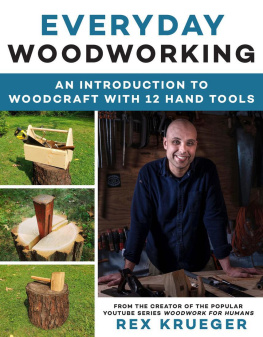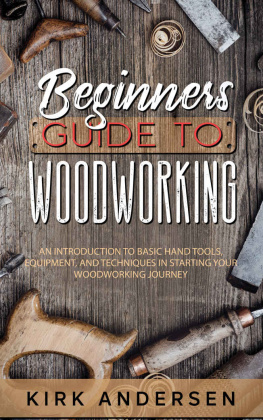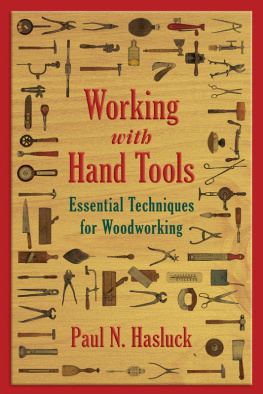WOODWORKING
The Complete Guide 2 Books in 1
Woodworking for Beginners and Projects
Bill J. Walker
Copyright 2020 by (Bill J. Walker)- All rights reserved.
This document is geared towards providing exact and reliable information in regard to the topic and issue covered. The publication is sold with the idea that the publisher is not required to render accounting, officially permitted, or otherwise, qualified services. If advice is necessary, legal or professional, a practiced individual in the profession should be ordered.
From a Declaration of Principles which was accepted and approved equally by a Committee of the American Bar Association and a Committee of Publishers and Associations.
In no way is it legal to reproduce, duplicate, or transmit any part of this document in either electronic means or in printed format. Recording of this publication is strictly prohibited and any storage of this document is not allowed unless with written permission from the publisher. All rights reserved.
The information provided herein is stated to be truthful and consistent, in that any liability, in terms of inattention or otherwise, by any usage or abuse of any policies, processes, or directions contained within is the solitary and utter responsibility of the recipient reader. Under no circumstances will any legal responsibility or blame be held against the publisher for any reparation, damages, or monetary loss due to the information herein, either directly or indirectly.
Respective authors own all copyrights not held by the publisher.
The information herein is offered for informational purposes solely and is universal as so. The presentation of the information is without contract or any type of guarantee assurance.
The trademarks that are used are without any consent, and the publication of the trademark is without permission or backing by the trademark owner. All trademarks and brands within this book are for clarifying purposes only and are the owned by the owners themselves, not affiliated with this document.
TABLE OF CONTENTS
WOODWORKING
FOR BEGINNERS
DIY Project Plans, Step-by-Step Guide to Learn the Best
Techniques, Tools, Safety Precautions and Tips to Start Your
First Projects with Illustrations and Much More!
Introduction

W oodworking can be defined as the art of making items from various types of wood with the help of tools. Woodworking is seen as one of the world's oldest trades, to produce both decorative and functional items.
Civilizations have used timber for centuries to produce useful, attractive, and ornamental items. Religion, architecture, agriculture, survival and recreational activities have featured prominently in woodworking throughout history. Humans could hunt more efficiently by developing woodworking skills, creating shelters, building boats and making life easier. Wood was used to create, bowls, spoons and furniture, and was also created as art. Woodworking reaches to social advancement.
Evolution of Woodworking and Woodworkers
For the early Egyptians, Jewish, Greek, Roman and all other ancient civilizations woodworkers were a very important part of society over 2000 years ago. Many illustrations show wooden furniture like beds, benches, stools, tables, shelves, etc.
Below are few exciting facts concerning these ancient Woodworkers:
The ancient Egyptians used to craft coffins using wood.
Ancient Egyptians discovered the art of veneering by the old examples shown at the tomb of Semerkhet died more than 5000 years ago. Most of the pharaohs got buried with artifacts that had ivory inlays and African ebony veneer.
According to the scholars, the Egyptians were the pioneers who varnished or "finished" their woodwork, although nobody knows how these "finishes" were composed.
Ancient Egyptians utilized tenon and mortise joints for joining timber together. These joints were strengthened by dowels, leather and Pegs.
They began to use animal glue from 1570 to 1069 B.C.
The common tools of the early Egyptian woodworker were Adzes, Axes chisel, bow-saws and pull-saws.
The art of woodworking was also promoted by early Chinese civilizations. Woodworking is thought to have been mushrooming in that nation beginning around 720 B.C. When this occurred, the Chinese established other advanced woodworking techniques, including detailed measurements that were used to create bowls, tables and the other furniture parts.
Today woodworkers who learn the early oriental woodworking practices feel proud in their knowledge of the designed joint and their determination not to use electrical tools, nails or adhesive to tie together their parts. That style of woodworking originated primarily in Japan.
Japanese woodworkers have also created exquisitely sculpted sceneries. Their fame and skills used in this process have spread throughout Southeast Asia. When a carpenter required wood, with the help of other workers, he used to saw trees in boards, with the help of a large bronze saw. He slice thin boards off the trunks of a tree. However, trees in that region weren't big or straight. The mallet, saw, adze, chisel, plummet and line, rule stick, squares and plane were among the carpenter's instruments mentioned in ancient sources. They used the bow drill also, held by the handle in one hand, which they quickly set in motion by pulling back and forth on the attached bow. The bow-lathe was a simple rudimentary instrument, but a professional woodworker was able to create elegant spindles and bowls along with it very much like the wood turners of today. He flipped the wood, pulling back and forth exactly like a bow with a leather strap. This motion shifted the lathe and made it possible to create the cut in the wood which twisted.
The ancient Near East woodworkers built great timber wooden boats that grew up on the Anatolian plateau (the Asian part of Turkey) with the Levantine coast (the coastal Mediterranean lands of present-day Syria, Lebanon and Turkey). This wood was too desired, that it was often demanded as a tribute by invading armies.
On the height of ancient Near East woodcarving, the windows made of wood of the ancient mosques and houses are now seen in the Arabic community were made., Syria, Egypt, Persia and Spain's Muslim woodcarvers crafted and produced beautiful paneling and other accessories for wall linings, floors, pulpits, and furniture and fittings of all sorts. Their woodwork was detailed and delicate to a minute. Woodworking process also came from these early people of craftsmanship, it's remarkable what they attained with 'primitive' instruments. Woodworking has developed into a very popular hobby and profitable profession. Hardware, lumber, and hobby stores can buy the tools and materials required for woodworking. Woodworkers design the wood using both hand tools and power equipment. Woodworking may involve carpentry, painting, design, spinning, furniture making, and more. As you can see, if you are passionate enough to pursue it, this could easily start out as a hobby and turn into an enjoyable career. Woodworking as a hobby can be very satisfying and bring you several hours of entertainment, along with the satisfaction of creating different things out of wood. While some people enjoy doing the actual woodworking, some prefer collecting and restoring beautiful works of art in wood. Woodworking is both soothing and exciting, particularly when you want to create stuff. To get started, all you need are tools, hardware and fundamental lessons which can help you get started. You can make a variety of decorative items, items you can use, and much more, when you work with wood. This book contains the basic information you need to know about a woodworker, the difference between a woodworker and other similar works, beginning with woodworking, pre-cut woodworking kits and DIY Projects, the beginner tools you need, safety rules and tips.


















